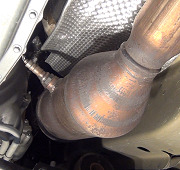Catalytic Converter could be leaking
The catalytic converter is our main line of defense against air pollution, so it's important to make sure it is functioning efficiently and passing exhaust without creating undue restrictions that might reduce performance, fuel economy or emissions. That's one of the reasons for periodic vehicle emissions testing. If the converter isn't working, you won't pass the test.
If the your converter is plugged, it will create a restriction in your exhaust system. The buildup of backpressure will cause a drastic drop in engine performance and fuel economy, and may even cause the engine to stall after it starts if the blockage is severe.
The easiest test for converter plugging is done with a vacuum gauge. Connect the gauge to a source of intake vacuum on the intake manifold, carburetor or throttle body. Note the reading at idle, then raise and hold engine speed at 2,500. The needle will drop when you first open the throttle, but should then rise and stabilize. If the vacuum reading starts to drop, pressure may be backing up in the exhaust system.
You can also try to measure backpressure directly. If your engine has air injection, disconnect the check valve from the distribution manifold, and connect a low pressure gauge. Or, remove the oxygen sensor and take your reading at its hole in the manifold or headpipe. Refer to the backpressure specs for the application. Generally speaking, more than 1.25 psi of backpressure at idle, or more than 3 psi at 2,000 rpm tells you there's an exhaust restriction.
If there appears to be an exhaust restriction, disconnect the exhaust pipe just aft of the converter to relieve pressure and recheck the readings. CAUTION: The pipes will be hot so wait awhile for things to cool down. If vacuum goes up and/or backpressure drops, the problem isn't not a plugged converter but a plugged muffler or collapsed pipe. If there's little or no change in readings, the converter is plugged.
Just because a converter is passing gas doesn't mean it is okay. If the catalyst inside is contaminated or worn out, high carbon monoxide (CO) and/or hydrocarbon (HC) readings will be present in the exhaust. If you have access to a high temperature digital pyrometer (or an oven thermometer will do), check the converter's temperature fore and aft. A good converter will usually run 100 degrees F hotter at its outlet than its inlet. Little or no temperature change would indicate low efficiency, or a problem with the converter's air supply. Converters need supplemental oxygen in the exhaust to reburn pollutants, so if the air injection system or aspirator valve isn't doing its job the converter can't do its job either.
Check the air injection pump, belt and check valve. If you suspect that the check valve is allowing exhaust to flow backwards, remove it and blow through both ends. It should let air pass in one direction, but not in the other. Examine the air injection manifold, too, because it tends to rust out and leak air. Check the diverter valve to make sure it is working correctly, too. It should be routing air to the converter when the engine is at normal temperature.
On engines with aspirator valves instead of air pumps, you should hear and/or feel the fluttering of the internal flapper as the engine is idling.
Causes Of Converter Failures
Fouling, clogging, melt-down and breakage of the ceramic substrate inside a converter are common conditions that can cause problems. Plugging is usually the end result of a melt-down, which occurs because the converter gets too hot. This happens because the engine is dumping unburned fuel into the exhaust. The excess fuel lights off inside the converter and sends temperatures soaring. If it gets hot enough, the ceramic substrate that carries the catalyst melts.
The unburned fuel may be getting into the exhaust because of a bad spark plug or valve, but an overly rich air/fuel mixture is another possibility. In older carbureted engines, a heavy or misadjusted carburetor float may be the underlying cause. But on newer engines with "feedback" carburetion or electronic fuel injection, the engine may not be going into "closed loop" (the normal mode where the computer regulates the air/fuel mixture to minimize emissions).
A bad oxygen sensor or coolant sensor may be giving the computer bogus information. A sluggish or dead O2 sensor will make the computer think the exhaust is running lean, so the computer will try to compensate by making the fuel mixture rich. A coolant sensor that always indicates a cold engine will also keep the system in open loop, which means a steady diet of excess fuel. But it might not be the sensor's fault. A thermostat that's stuck open or is too cold for the application can prevent the engine from reaching its normal operating temperature. So if your converter has failed and needs to be replaced, the engine should be diagnosed for any underlying problems before the new converter is installed.
Another cause of converter clogging and contamination is excessive oil consumption. Worn valve guides or seals can allow oil to be sucked into the engine's combustion chambers. The same goes for worn or damaged rings or cylinders. Oil can form a great deal of carbon, and metals present in the oil can contaminate the catalyst. A compression check or leak-down test will tell you if the rings are leaking, while a fluttering vacuum gauge needle will help you identify worn valve guides.
Friday, January 10th, 2020 AT 12:12 PM
(Merged)


